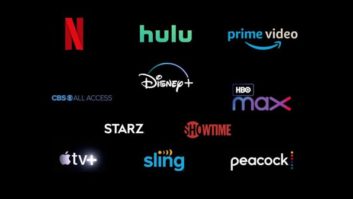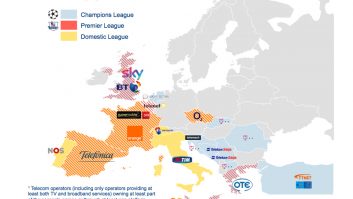Sports content is big business, attracting audiences equally as large. The monetary figures associated with ads and sponsorship for premium sports content are astounding. A 30 second ad during the 2018 Super Bowl is rumoured to have cost $7.7 million, an increase of $2.7 million over last year.
Despite the popularity of sports content, many have doubted whether streaming sports content OTT could ever compete with traditional viewing. Latency has always been a major issue for OTT sports, particularly given that a 30-second delay for some providers is considered the norm, whereas for satellite broadcasters a figure below five seconds is more realistic.
Although this latency does present a challenge, it is not wholly impossible to provide sports OTT. There are a number of ways OTT providers can attract audiences, thanks in part to technological developments in OTT delivery. By making the experience more attractive to viewers and adding value beyond that of live coverage, OTT sports content could prove an attractive alternative or addition for consumers. In fact, big internet players have recognised this opportunity and are now entering the OTT sports business. Amazon, for example, recently paid $50 million to stream 10 NFL games for Prime members.
Changing Habits
Viewing stats for several large sports events point to a considerable change in consumer behaviour over the last few years. The first 10 nights of NBC’s coverage of the Rio Olympics was down 17 per cent in audience size compared to that of the 2012 games in London. This is significant given that the time difference between the East Coast and London stands at five hours whereas US viewers were only one hour behind Rio. This means, therefore, that while US viewers could, for the most part, only watch the action from London after the event, Rio’s coverage could be watched more or less live in the US.
However, on one Sunday during the games, online users streamed 1.86 billion minutes of NBC’s coverage, beating the combined number for both London 2012 and the Sochi winter games of 2014. Clearly, the audience is still there, meaning it’s unlikely that sports itself is declining in popularity. NBC also revealed that 190 million minutes of Olympics highlights and behind-the-scenes action were viewed on its Snapchat channel and via its social platform’s live service. What this points to is a demographic looking for more freedom to choose where, when and in which way they consume, and more importantly engage, with sports content.
Additional Engagement
Sports fans are a particularly unique demographic. They tend to consume sports content in a wholly different fashion to the way in which the average viewer would watch a movie, for example. Fierce loyalty to specific teams has always been a pronounced trend, but another is that sports fans are always looking for additional ways to engage with sports content. In a recent study, 80 per cent of fans claimed to be second-screening, saying they had accessed content on their mobile device whilst viewing a live event on television. This engagement typically includes participating in online conversations, watching memorable highlights from a game, as well as behind the scenes footage or interviews, and looking up interesting stats about games, teams and players/athletes.
This demand for additional content presents an opportunity to increase the value and attractiveness of consuming sports content OTT, which could enable OTT providers to add value to traditional consumption. There is a growing demand for more flexible viewing options, a demand which OTT could satisfy. In fact, a recent survey found that 73 per cent of sports fans think it is important that they are able to access content wherever they want. In reality, it is difficult to imagine that anyone would choose not to have this option. On top of this, despite the NFL experiencing a decline in TV ratings, the number of people streaming NFL games has actually increased by 25 per cent, according to USA Today.
But furthermore, what if OTT providers could provide this content to viewers via the same OTT viewing experience providing live sports – and, what if this content was personalised to the specific viewer based on their favoured sport, team or athlete (as well as other data such as location)? According to a whitepaper from Comcast, the combined international fan base of three of the 20 English Premier League teams exceeds 210 million, spanning countries ranging from Venezuela to Vietnam. If an OTT provider could tap into a market of such proportions, using data to target additional content according to specific viewers, OTT sports could complement traditional viewing with something valuable and unique.
Increasing the Value
Mobile viewing on personal electronic devices is steadily increasing, and thanks to the metadata described within sports content, this offers OTT providers a large amount of viewer-specific data. It is possible, with metadata, to apply graphics to a video stream which could be personalised depending on specific viewer data. These graphics would also be user selectable, so statistics about a player’s movements during a game, the number of times the teams playing have faced one another in the past, or perhaps an athlete’s personal bests could all be called up on demand – all the while the live content continues to play.
There is also the possibility of automatic clip generation. AI technology is capable of recognising and isolating memorable events within sports content such as touchdowns, goals and so on. Sports data companies can provide detailed XML files describing the actions in the game with x,y,z coordinates and timestamps. By marking the live game using the game clock, the video sequence can automatically be matched to the XML files, opening up the possibility of automated highlights generation. The goals in all soccer matches could be posted on social media, for example, or it could be made available to the OTT viewer as and when they choose. Using personalised data, targeted ads can also be inserted at the front and mid-way through (for longer clips) for added value.
Conclusion
Much of what has been discussed in this article would not have been possible several years ago. Now, with advancements in OTT technology, providers have more sophisticated, cost-effective tools to engage viewers and extract the value from sports content. In 2016, the NBC network made video content of every Olympic event available on its app, where it also streamed prime-time coverage, for the first time.
Clearly, the OTT sports market is in its infancy, but we may well be on the precipice of its expansion. It seems reasonable to predict that the next Olympics could therefore be the first truly OTT Games yet.







